SSC CGL Exam > SSC CGL Notes > General Awareness for SSC CGL > Acids, Bases and Salts
Acids, Bases and Salts | General Awareness for SSC CGL PDF Download
| Table of contents |

|
| Acid and Base |

|
| Indicators |

|
| pH Scale |

|
| Salts |

|
Acid and Base
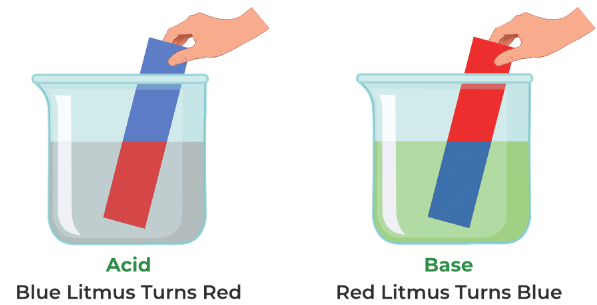
- In our everyday lives, we use various substances like lemon, tamarind, salt, sugar, baking soda, and vinegar. Sour substances are known as acids (Acid comes from the Latin word "acere," meaning sour).
- On the flip side, some substances such as baking soda taste bitter. When we rub a baking soda solution between our fingers, it feels slippery like soap. These bitter substances are classified as bases.
- Acids derived from plants and animals are termed organic acids, for example, lactic acid, oxalic acid, acetic acid, uric acid, etc. Acids obtained from minerals are referred to as mineral acids, like sulfuric acid (H2SO4), phosphoric acid (H3PO4), etc.
Arrhenius Concept of Acids and Bases
- Acid is a substance that can release H+ ions in water, like hydrochloric acid (HCl) and sulfuric acid (H2SO4).
- Base is a substance that can release OH- ions in water, such as sodium hydroxide (NaOH) and ammonium hydroxide (NH4OH).
Bronsted Lowry Concept of Acids and Bases
- An acid is a molecule or ion which is capable of donating a proton and a base is a molecule or ion which is capable of accepting a proton.

Lewis Concept of Acids and Bases
- According to Lewis, an acid is a substance that can accept an electron pair, and a base is a substance that can donate an electron pair. Compounds where the central atom doesn't have a complete octet are known as Lewis acids.
- Examples of Lewis acids include boron fluoride (BF3), aluminium chloride (AlCl3), carbon dioxide (CO2), and sulphur dioxide (SO2).
- Examples of Lewis bases are fluoride (F–), chloride (Cl–), iodide (I–), bromide (Br–) ions, water, and alcohols, among others.
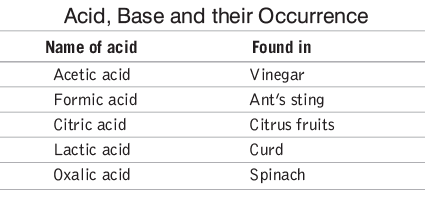
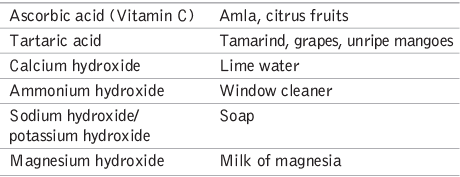
Indicators
- We can't test every substance, so we use special substances called indicators to test if something is acidic or basic. These indicators change color when added to a solution with acid or base.
- Natural indicators like turmeric, litmus (from lichens), and China rose petals are commonly used.
- Examples of acid-base indicators include methyl orange, methyl red, phenolphthalein, litmus, and bromocresol green.
- Phenolphthalein isn't good for weak bases like ammonium hydroxide, and methyl orange isn't suitable for weak acids like acetic acid.
- Acid-base indicators help differentiate between acids and bases, while the pH scale measures the strength of acidic or basic solutions.
Question for Acids, Bases and SaltsTry yourself: Which of the following substances is classified as an acid based on the Arrhenius concept?View Solution
pH Scale
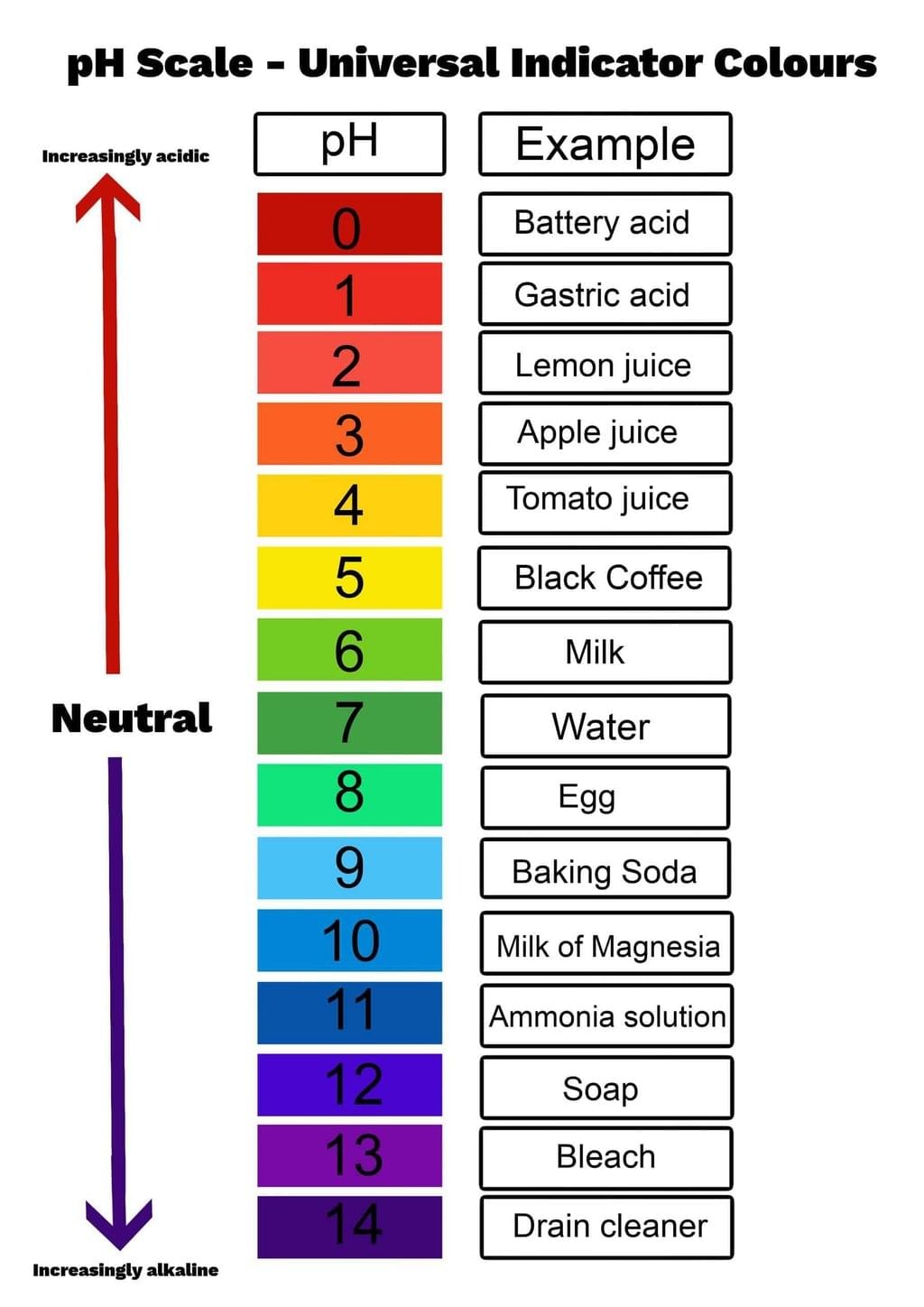
- pH value indicates if a liquid is acidic or basic. Acidic solutions have pH less than 7, while basic solutions have pH greater than 7. Pure water’s pH is close to 7.
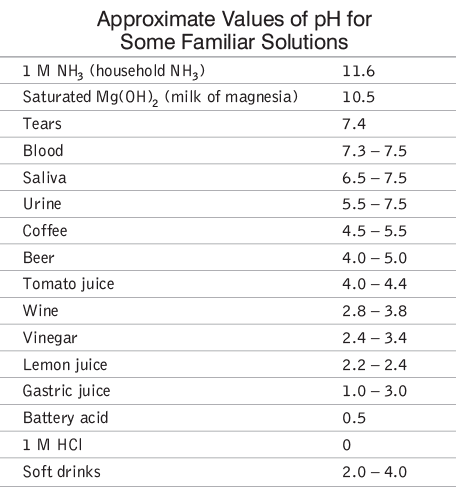
- The pH of a liquid is a measure that shows how acidic or basic it is. It is calculated as the negative logarithm (base 10) of the hydrogen ion concentration in moles per liter. The formula is pH = -log [H+].
- Plants and animals need a specific pH level to survive, usually ranging between 7.0 and 7.8.
- pH plays a crucial role in farming. Farmers test soil pH to decide if they need acidic or basic fertilizers for a specific crop.
- Human blood’s pH ranges from 7.36 to 7.42. Even a small pH shift of 0.2 can be fatal.
- pOH, the opposite of pH, measures the hydroxide ion concentration in a liquid. It is calculated as the negative logarithm of the hydroxide ion concentration. The formula is pOH = -log [OH-] or pH + pOH = 14.
Buffer Solutions
- The special solutions that don't easily change their pH when a bit of acid or base is added are known as buffer solutions.
- These solutions have a specific pH value.
- Acidic buffer solutions have a pH lower than 7 (equal parts of acetic acid CH3COOH and sodium acetate CH3COONa).
- Basic buffer solutions have a pH higher than 7 (equal parts of ammonium hydroxide NH4OH and ammonium chloride NH4Cl).
- The pH of blood stays stable due to the H2CO3 / HCO3- buffer, despite consuming acidic foods.
Salts

- Acids make blue litmus paper turn red, while bases turn red litmus paper blue.
- When you mix the right amounts of an acid solution and a base solution, their acidic and basic properties cancel out, resulting in the formation of salt. This process is called a neutralization reaction. During neutralization, salt and water are created, releasing heat.
- When an ant bites, it releases an acidic solution (formic acid) into the skin. You can counter its effects by applying damp baking soda or calamine solution, which contains zinc carbonate.
- In our stomach, hydrochloric acid aids in food digestion. However, excessive stomach acid leads to acidity. To alleviate acidity, we use an antacid like milk of magnesia, which contains magnesium hydroxide. It helps neutralize excess acid.
- Overuse of chemical fertilizers can make the soil acidic. Plants struggle to thrive in overly acidic or basic soil. If the soil is too acidic, it can be treated with a base such as quick lime or slaked lime.
Types of Salts
- Normal salts like sodium chloride and sodium nitrate do not have a hydrogen or a hydroxyl group that can be replaced.
- Acidic salts such as sodium hydrogen carbonate and sodium hydrogen sulphate contain replaceable hydrogen atoms.
- Basic salts like magnesium hydroxyl chloride and zinc hydroxyl chloride contain replaceable hydroxyl groups.
- Double salts like Mohr's salt and potash alum are formed by combining two simple salts.
- Complex salts, such as potassium ferrocyanide, result from combining simple salts in their aqueous state.
- Mixed salts, like bleaching powder, yield multiple cations or anions when dissolved in water.
Salt Hydrolysis
- The process where a salt reacts with water to create an acidic, basic, or neutral solution is known as salt hydrolysis.
- When a salt is formed from a strong acid and a strong base, it remains neutral when dissolved in water.
- Sodium chloride (NaCl) is a salt resulting from a strong base, sodium hydroxide (NaOH), and a strong acid, hydrochloric acid (HCl).
- Potassium chloride (KCl) is a salt derived from a strong base, potassium hydroxide (KOH), and a strong acid, hydrochloric acid (HCl).
- Salts formed from a strong acid and a weak base undergo hydrolysis in water, leading to an acidic solution.
- Ferric chloride (FeCl3) is a salt of a weak base, ferric hydroxide [Fe(OH)3], and a strong acid, hydrochloric acid (HCl).
- Copper sulphate (CuSO4) is a salt of a weak base, copper hydroxide [Cu(OH)2], and a strong acid, sulfuric acid (H2SO4).
- Salts resulting from a weak acid and a strong base undergo hydrolysis in water, resulting in a basic solution.
- Sodium carbonate (Na2CO3) is a salt of a strong base, sodium hydroxide (NaOH), and a weak acid, carbonic acid (H2CO3).
- Sodium acetate (CH3COONa) is a salt of a strong base, sodium hydroxide (NaOH), and a weak acid, acetic acid (CH3COOH).
- Salts formed from a weak acid and a weak base undergo hydrolysis in water, leading to an acidic, basic, or neutral solution.
- For instance, ammonium acetate (CH3COONH4) produces a neutral solution upon hydrolysis. It originates from a weak acid, acetic acid, and a weak base, ammonium hydroxide.
Question for Acids, Bases and SaltsTry yourself: Which type of salt undergoes hydrolysis in water, resulting in an acidic solution?View Solution
The document Acids, Bases and Salts | General Awareness for SSC CGL is a part of the SSC CGL Course General Awareness for SSC CGL.
All you need of SSC CGL at this link: SSC CGL
|
448 videos|1497 docs|288 tests
|
FAQs on Acids, Bases and Salts - General Awareness for SSC CGL
| 1. What is the pH scale and how is it used to measure acidity and alkalinity? |  |
Ans. The pH scale is a measure of how acidic or basic a substance is, ranging from 0 (most acidic) to 14 (most basic). It is used to quantify the concentration of hydrogen ions in a solution, with lower pH values indicating higher acidity and higher pH values indicating higher alkalinity.
| 2. What are some common examples of acids and bases found in everyday life? |  |
Ans. Common examples of acids include lemon juice, vinegar, and battery acid, while common bases include baking soda, soap, and ammonia. These substances can be identified by their sour (acids) or bitter (bases) taste, respectively.
| 3. How do salts form and what are their properties? |  |
Ans. Salts are formed through the reaction between an acid and a base, resulting in the formation of a neutral compound. They are typically crystalline solids that are composed of positively and negatively charged ions. Salts are often used in various industries, such as in food preservation and water softening.
| 4. How do acids and bases react with each other to form salts? |  |
Ans. When an acid reacts with a base, they undergo a neutralization reaction where the hydrogen ions from the acid combine with the hydroxide ions from the base to form water. The remaining ions combine to form a salt.
| 5. How can the pH of a solution be adjusted to make it more acidic or basic? |  |
Ans. The pH of a solution can be adjusted by adding acids (to increase acidity) or bases (to increase alkalinity). For example, adding lemon juice (acid) to water will lower its pH, while adding baking soda (base) will raise its pH.
Related Searches















